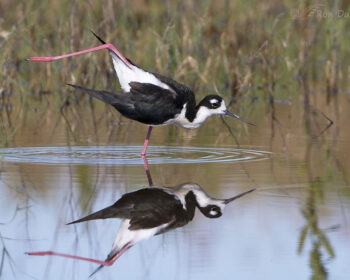Tag: leg stretch
Anticipating An American Avocet Behavior
Anticipating behaviors is often crucial for nature photographers and that’s particularly true when your subject is a lightning-fast bird. Most of us don’t need any more images where the wings have been cut off in the frame or the bird is soft due to lack of shutter speed or poor focus tracking of the bird at take-off. The American Avocet in breeding plumage is an especially lovely subject with its long recurved bill, bluish legs, cinnamon head and neck and the black and white chevron pattern on its back. But you don’t see many quality flight or take-off images of the species, partially because their flight tendencies are fast and erratic. Like many birds, avocets routinely perform single wing and leg stretches. These stretches occur when the bird is at rest and at ease. They stretch like this in the water… and on land. But this single-wing/leg stretch is not an indicator of nervousness or a precursor of take-off. Neither of the birds in these two images did so immediately after the stretch. 1/1000, f/8, ISO 500, 500 f/4, 1.4 tc, natural light, a sliver of canvas added for composition But when you see this two-winged wing stretch, expect imminent take-off. A few seconds later this bird did just that but it took off away from me and I deleted the images. Another two-wing stretch. And almost immediately after the wings came down… the bird took off. It’s not a good shot because of the angle of take-off but it illustrates my point. Here’s what Birds…
Western Grebes: A Bizarre Behavior Finally Explained
Anyone who has spent a significant amount of time observing Western Grebes (or their close relatives, Clark’s Grebes) has undoubtedly observed this curious behavior multiple times. But before I continue, a few words of explanation are in order. Grebes are unique to most other water birds in two ways that are related to this behavior: 1.) their legs are attached to their bodies at the rear, rather than underneath and 2.) the toes of grebes are lobed instead of webbed. Having legs attached at the rear allows for efficient swimming but causes extreme clumsiness while walking – they rarely venture on to land, but when they do they often fall down after just a few steps. This leg attachment position is so distinctive of grebes that the genus name of four of the North American grebe species is Podiceps (from “podicis” meaning anus or vent and “pes” meaning foot) – in other words, “anus foot”. (and yes, I’m having a hard time resisting a joke line or two with that phrase…) Recent experimental work with grebes has demonstrated that the lobes on the toes function much like the hydrofoil blades of a propeller. Ok, with that background, on to this strange behavioral quirk of the Western Grebe. Without warning, and for no apparent reason, they stick one of their legs out behind them. With those unusual feet it can look pretty silly. Sometimes they’ll do a simultaneous wing stretch, but rarely. Occasionally they’ll hold the foot high in the air for quite a while. That can look even sillier. Even the chicks do it….


